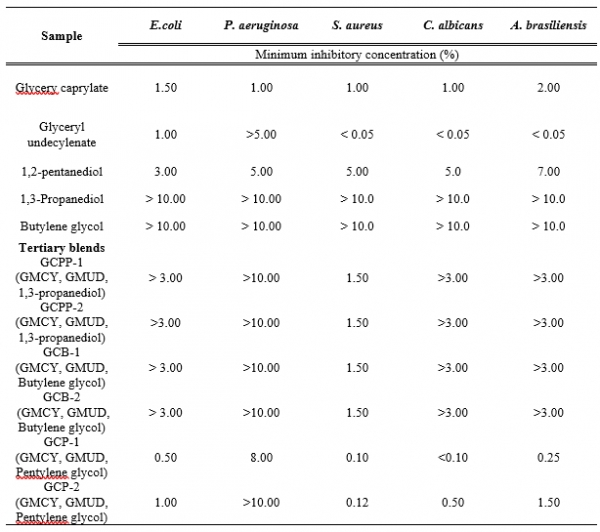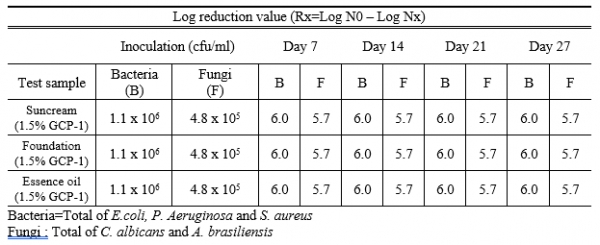Myungchan CHO
ACTIVON CO., LTD., Chungchengbuk-do, Republic of Korea
* Myungchan CHO, +82-070-8786-1721, mccho1311@activon.kr
ID:545
Abstract
Background: The combination of natural derived compounds glyceryl undecylenate, glyceryl caprylate and other glycols are skin friendly and they exhibited great antimicrobial activity. In current study, the antimicrobial activity of these nature derived compounds was evaluated against gram-positive, gram-negative bacterial and fungi after their combination with w/o and w/s formulations.
Methods: In this study, we evaluated the preservation efficacy of combination of natural derived compounds glyceryl undecylenate, glyceryl caprylate and other glycols (emulsion type) according preservative efficacy test (PET) used PCPC (personal care products council) guideline test for w/o and w/s formulation.
Results: Three types of ingredients (plant derived 1,3-propanediol, 1,3-butylene glycol and 1,2-pentanediol) were considered for blending to improve the antimicrobial effect along with stability in w/o and w/s formulation. In current investigation, it has been observed that the complex of glyceryl undecylenate and glyceryl caprylate and 1,2-pentanediol found be very stable, and it have provided excellent antimicrobial activity. Moreover, this complex showed superior antimicrobial activity and stability than the complex with 1,3-propanediol and 1,3-butylene glycol.
Conclusion: The complex of natural combination with 1,2-pentanediol can be potential candidate as alternative preservative as well as high quality cosmetic ingredient.
Keywords: Plant derived, skin friendly, antimicrobial activity, oil formulation
Introduction
A substance, such as preservatives have been added to food, cosmetics, and medicines to prevent spoilage caused by formation of microorganisms, which results from the proliferation of microorganisms or unwanted chemical changes. In general, cosmetics are composed of water, oil, moisturizers, thickening agents, surfactants, and functional ingredients. However, adequate levels of water and nutrients needs to maintain for survival of microorganisms.[1] [2]
Cosmetics can be easily exposed to microorganisms such as bacteria, yeast and mold when it used with hands or devices. The resultant microbial contamination of cosmetics can cause microorganism-induced decomposition or alteration, and side effects on the skin or protective membranes due to microbial metabolites, which could limits the normal use of cosmetics in many cases. Hence, it became mondatory to preserve the cosmetic products and protect them form microbial spoilage. In this action, Cosmetic industries are extensively using synthetic chemical as preversatives such as paraben, formaldehyde releasers, isothiazolinones, triclosan to delay the degradation caused by microbial growth, enzyme activities and oxidation reactions.[3] However, extensive use of parabens can create allergic iuuse in human body, and their accumulation in the human body can disturb the endocrine system and generate resistant bacteria. Due to related limitation of parabens, it is banned in South Korean cosmetics. Controversy over the safety of preservatives has created constant needs for new and safe ingredients for preservatives. However, significant research and investigations is necessary to find an efficient preservative candidate, which should be nature drived. In this urgent searching compitation, cosmetic industries as well as researchers are more concerns about the development of alternative candidates, which should provide wide antimicrobial spectrum, effective at low concentrations, ensure cost competitiveness and smooth supply, easily applicable to cosmetic formulations, and maintain safety when cosmetics are applied to the skin.[4] [5]
As discussed above, microbial spoilage is the major problems that decrease the shelf-life of cosmetic products and product safety. By considering the urgency in related area, we developed plant derived chemical combinations (short ~ medium-chain (C3~12) free fatty acids and their against), which is very efficient and it has showed comparative antimicrobial properties. The developed plant derived chemical combination can be used as natural multifunctional, and their potential properties such as antimicrobial, bio-compatibility allow it for utilization in the important applications related to cosmetic oil formulation.
Materials and Methods
Test organisms
The strains used in the test were selected as suggested in the PCPC(personal care products council) microbiology guidelines. Escherichia coli(ATCC 8739), Staphylococcus aureus(ATCC 6538), Pseudomonas aeruginosa(ATCC 9027), Candida albicans(ATCC 10231) and Aspergillus brasiliensis(ATCC 16404)) purchased from ThermoFisher Scientific Inc. (Waltham, MA, USA) was used in this study.
Test product
We compared combination of natural derived compounds glyceryl undecylenate, glyceryl caprylate and other glycols (1,3-propanediol, 1,3-butylene glycol and 1,2-pentanediol).
Storage stability test and content ratio of ternary composition
The storage stability was evaluated after preparing a ternary composition of glyceryl undecylenate, glyceryl caprylate and three different types of glycols (1,3-propanediol, 1,3-butylene glycol and 1,2-pentanediol). The stability of these compositions was confirmed at different temperatures (-18 oC, 5 oC and 25 oC) for 72 h. The related results (changes in content ratio) are presented in table 1. In this experiment, the combination of each diol was kept at the desired temperature in the incubation and refrigerator.
The minimum inhibitory concentration test (antimicrobial efficiency)
Antimicrobial activity of the prepared chemical combination was confirmed through MIC tests using bacteria (E. coli, S. aureus, and P. aeruginosa), yeast (C. albicans), and mold (A. brasiliensis). In addition, the effect of diol dilution in these combinations (0.01%~5%) was evaluated. A series of samples with different diol concentrations were prepared in a liquid microbial growth medium, and inoculated these samples with a standardized number of organisms (106/ml of bacteria, 105/ml of yeast, and mold) for 24h to 48h, and confirmed the antimicrobial activity virtually.
The challenge test (preservation efficiency)
Preservation efficacy of prepared combinations was evaluated in w/o (sun cream) and w/s (foundation) formulations and essence oil as per PCPC guidelines [6]. The generated microorganisms were counted and the quantities of the inoculum were demonstrated as follows: 1.1 x 106cfu/ml of bacteria and 4.8 x 105cfu/ml of yeast and mold. The resultant bacteria were incubated at 30~32°C, whereas yeast and mold were incubated at 25°C individually. As a result of the test, the number of living microorganisms in the cosmetic sample was confirmed on 7 days, 14 days, 21 days, and 28 days after microorganism inoculation.
Antimicrobial activity (Agar well diffustion test)
The antimicrobial activity of the complex of glyceryl undecylenate, glyceryl caprylate and 1,2-pentanediol was investigated by the modified agar well-diffusion method, as per Clinical and Laboratory Standards Institute guidelines (2013). Cutibacterium acnes was incubated separately in tryptic soy broth (TSB) with 1% glucose solution for 24 h under aerobic conditions at 35°C, and adjusted to yield approximately 1.0 x 108 cfu/ml. The antibacterial activity was evaluated by measuring the diameter of zones of inhibition (unit mm).
Results
Storage stability test and content ratio of ternary composition
The preservation efficiency was presented in table 1. It has been observed that the complex of glyceryl undecylenate, glyceryl caprylate, and 1,2-pentanediol was found to be very stable for the tested period of time. Furthermore, this complex was more stable than the complex containing 1,3-propanediol and 1,3-butylene glycol. In particular, the GCP-1 existed in a liquid state at a low temperature of 5 oC. These experimental results indicate that the storage stability problem pointed out as a traditional problem may be solved by changing the number of carbon atoms in glycol. Thus, we selected the composition of GCP-1 for antimicrobial activity.
Result of the MIC test
The results of the MIC test are presented in table 2, which shows the level of antimicrobial activity. The lowest concentration of test agent preventing the appearance of turbidity (growth) is considered to be the minimum inhibitory concentration (MIC). Thereafter, the state of bacteria, etc. was observed, and a concentration that significantly inhibited the number of the seeded initial strains was determined as a minimum inhibitory concentration (MIC). In this experiment, the combination of (glyceryl undecylenate, glyceryl caprylate, and pentylene glycol) showed excellent antimicrobial activity as compared to other tested diols.
Result of the challenge test
Preservative efficacy of a combination of glyceryl undecylenate, glyceryl caprylate, and a glycol compound according to the components and contents shown in Table 3. Interestingly, all the combinations showed excellent preservation efficiency in all format samples (sun cream, foundation, essence oil). Among the tested combinations, GCP-1 showed excellent antimicrobial activity at 1.5% concentrations in all the formats of cosmetics: sun cream, foundation, and essence oil.
Antimicrobial activity
The zones of inhibition for the complex of glyceryl undecylenate and glyceryl caprylate and 1,2-pentanediol using 1.5% and 2.0% was obatined to be 13 mm and 23 mm respectively. The results are presented in Figure 1. The determined range of zone is desired for the effective for the desired antimicrobeal activity. Hence, the combination with pentylene glycol can be desired candidate to utilized it in antimicrobeal activity.
Discussion
As discussed above, microbial spoilage is the major problem that decreases the shelf-life of cosmetic products. The cosmetic industry, up to recently, extensively used synthetic preservatives. The developed bio-based chemical combination of three different diols was tested for antimicrobial activity and perpetration efficiency under different conditions. Notably, bio based preservatives are a good alternative to maintain the safety and quality of their products. The effectiveness of these combinations was tested using three different tests. The combination of natural derived compounds glyceryl undecylenate, glyceryl caprylate, and other glycols is skin-friendly and has high antimicrobial activity. activity of these naturally derived compounds was evaluated against gram-positive, gram-negative, and fungi after their combination with w/o and w/s formulations. It has been observed that the complex of glyceryl undecylenate, glyceryl caprylate, and 1,2-pentanediol has been found to be very stable, and it has provided excellent antimicrobial activity. As per stability and activity results, the complex of natural combination with 1,2-pentanediol can be a potential candidate as an alternative preservative as well as a high-quality cosmetic ingredient. This complex showed superior antimicrobial activity and stability than the complex with 1,3-propanediol and 1,3-butylene glycol. From the obtained results, it has been demonstrated that the longer carbon chains of diols are very stable, and the related complex showed superior antimicrobial activity.
Conclusion
The present study was conducted to find out the potency of a ternary composition of glyceryl caprylate, glyceryl undecylenate and pentylene glycol at different compositions. Under the tested conditions, the pentylene glycol complex outperformed the complexes with 1,3-propanediol and 1,3-butylene glycol in terms of antimicrobial activity and stability. Thus, these bio-based complexes can be potential candidates as alternative preservatives as well as high quality cosmetic ingredients.
Acknowledgments
The author thanks to co-worker of ACTIVON for their help
References
1. Jung Eun Ku(2013), The Recent Trend of the Natural Preservative Used in Cosmetics. Kor. J. Aesthet. Cosmetol 5:835-844
2. Michel M. Beya et al.(2021) Plant-Based Phenolic Molecules as Natural Preservatives in Comminuted Meats: A Review Antidoxidant(Basel) 10(2): 263
3. Smith CN, Alexander BR(2005) Toxicology in Vitro 19: 963969
4. Basketter DA(1997) The classification of skin irritations by human patch test. Food and Chemical Toxicology 35:845-852.
5. Yong Hyun Kim et al. (2021) Comparison of Preservative Efficacy Tests for Water Non-dispersible Cosmetic Formulations 47:1
6. Personal Care Products Council Technical Guidelines 2018 Edition




